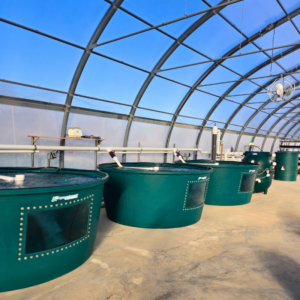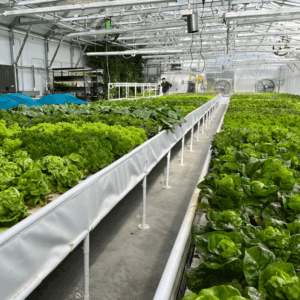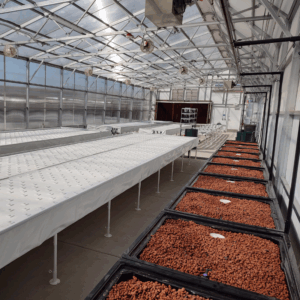What Is Aquaponics?
Aquaponics is the integration of:
Aquaculture–Farming aquatic species in a
controlled environment
&
Hydroponics–Growing plants in soil-less media
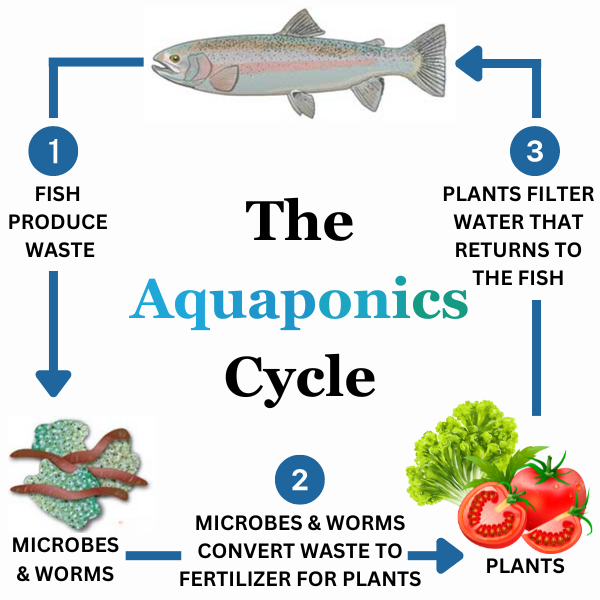
A Balanced Ecosystem
Aquaponics reuses the waste water from aquaculture as a natural source of fertilizer for the hydroponic plant system in a continuous recirculating system.
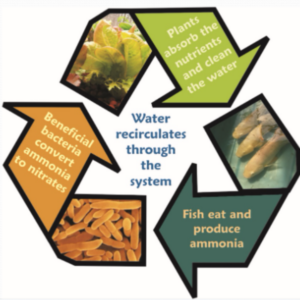
Cultivating Bacteria
Aquaponic systems rely on nitrifying bacteria to naturally convert the harmful ammonia into a nitrogen-rich fertilizer. Bacteria colonize on all of the submerged surface area and help to maintain a healthy water for the fish while also providing soluble nutrients for the plants!
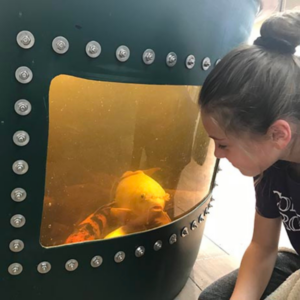
Raising Fish
In aquaponics we raise fish at low stocking densities to ensure good water quality and the growth of happy, stress free fish. When we feed the fish, they produce ammonia, which left unfiltered, can become toxic to the fish. Proper filtration of solid waste, aeration, temperature and water quality monitoring is essential.

Growing Plants
The plant roots take up the nitrates, trace minerals and nutrients from the water. The roots help to filter the water which is returned back to the fish. The water is continuously recirculating so plants are constantly receiving warm nutrient rich water resulting in tremendous growth.
Systems & Solutions
At The Aquaponic Source, we specialize in custom aquaponics, hydroponics, and aquaculture system design. With decades of experience, we help individuals, schools, and commercial growers build closed-loop, sustainable food systems that conserve water and produce year-round harvests.

Aquaponics at Home
One of the greatest benefits we have enjoyed with aquaponics is growing food for our family. Eating healthy food is a goal for a lot of people, but depending on where you live, it might not be easily accessible, affordable or available year-round.
With a well designed home aquaponic system, growing food year round with a lot less water and labor is a reality. We offer classes, custom systems and supplies and hope to empower everyone to grow their own healthy food at home.
Our Process
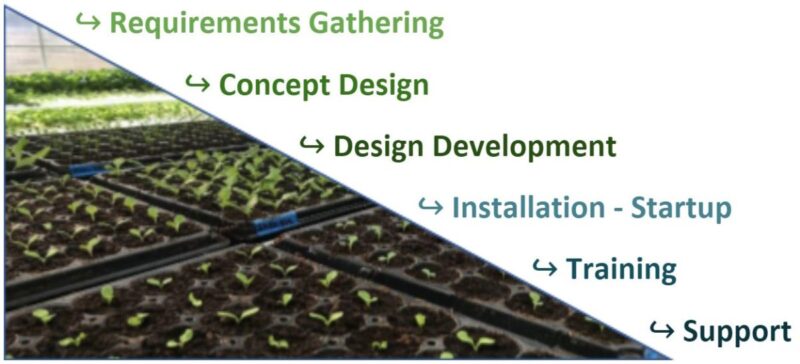
Developing a custom home system or an aquaponic farming business can involve several steps. For us it all begins with listening and goal setting. We will work with you to establish a design, installation and training plan to give you the best opportunity to succeed.
We want to get the project right from the initial planning stages to your first harvest and beyond. Our farm design and engineering program allows us to create an ecologically balanced aquaponic system for any scale. Click here to learn more about our services
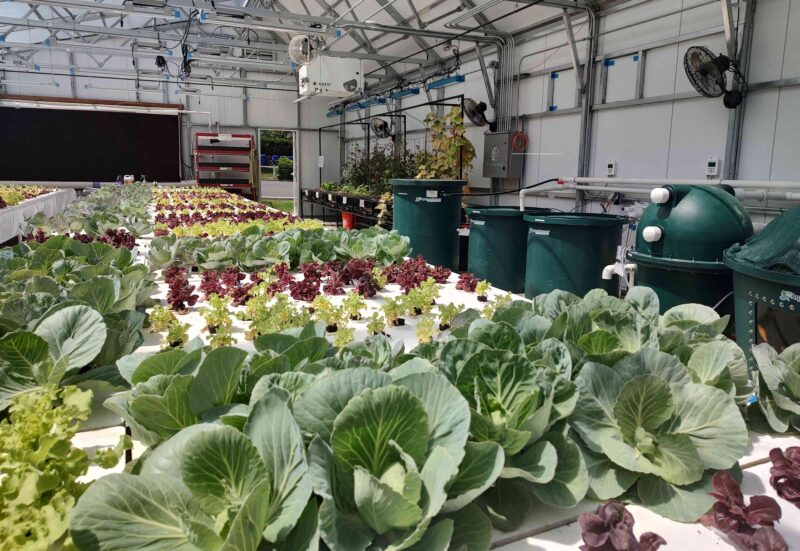
Some have claimed that aquaponics can’t be profitable at a small scale. We proved that aquaponics can be profitable with the right system, a good business plan, proper training and a resolve to overcome any obstacle.
At The Aquaponic Source, we have assembled a great team to help design, manufacture, install and support farm systems all over North America.
We are extremely proud of our aquaponic farmers. They are doing amazing work in their communities growing nutritious produce and educating others on the many benefits of aquaponics. Please visit Our Projects page to learn more about their farms.
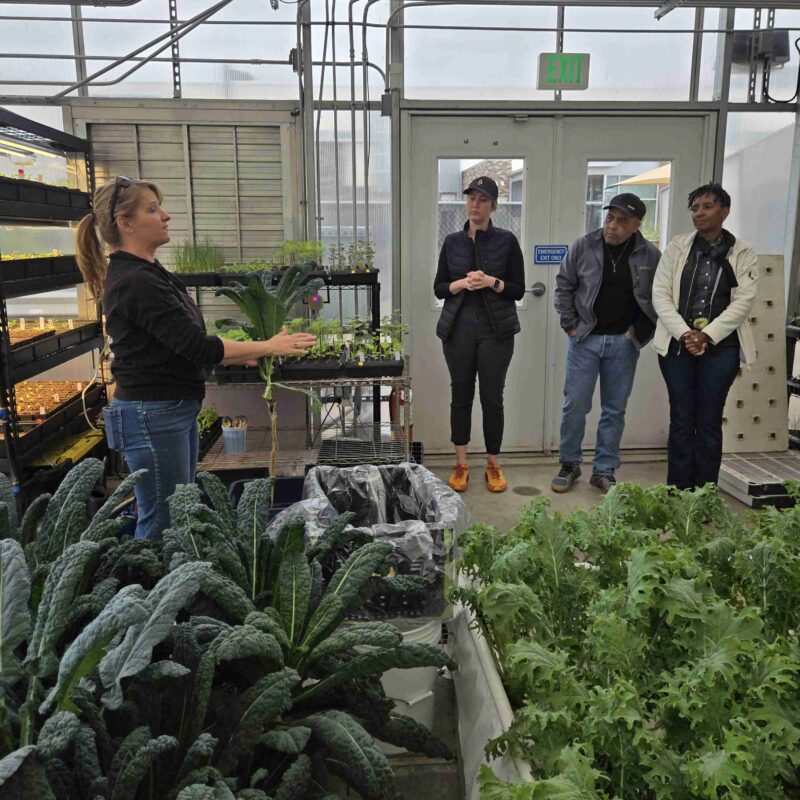
New to gardening or never raised fish before? No problem! Aquaponic Basics will introduce you to the core principles that allow fish, plants and bacteria to work together in a natural recirculating ecosystem.
Our class covers all of the basic information needed to design, build, and run your system successfully. We will address common plumbing configurations, component sizing options, and give you all the tips to avoid making mistakes.
The Flourish Farm Aquaponic Farming Course includes all of our online farming course modules which you can complete anytime at your own pace. In addition to the online course, you will attend a two day in-person workshop focused specifically on farm operations and management essentials that are critical for running a successful aquaponic farming business.
Years of aquaponic farming experience are now available online with the Flourish Farm Online Course. Learn at your own pace in the comfort of your own home.
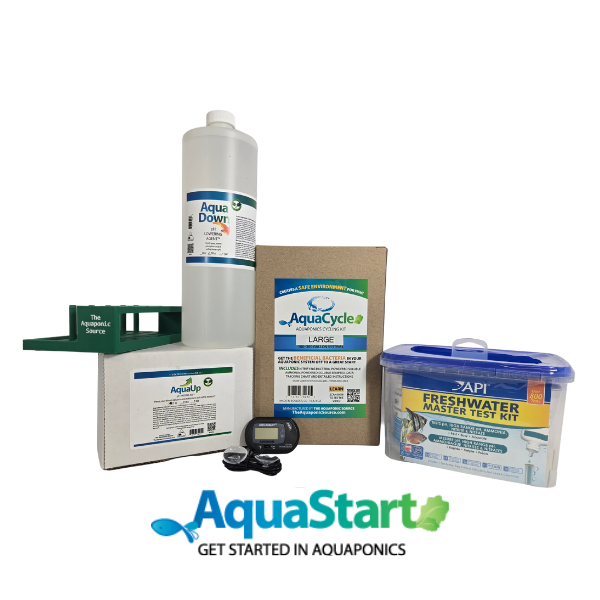
Our Shop has everything you need from restock supplies, counter top systems to all the plumbing equipment you need to start your own aquaponic, hydroponic, or aquaculture project.
Most of the equipment included with our complete systems is available piecemeal for purchase so that you have the tools needed to complete your own system at home.
FAQs
Yes! Our newsletter is released quarterly and features exclusive deals, farm updates, industry news, & so much more! Just enter your email below to enter our mailing list.
If you’re starting from scratch and are considering using a greenhouse for aquaponics, we have some resources for you.
First check out our free Aquaponic Greenhouse Design Considerations video that was presented at the 2020 Aquaponics Association Annual conference by JD. This can be found on our Video Resources Page.
We also have a detailed Getting Started Checklist that walks you through important considerations when planning your space or greenhouse.
If you want to dive in deeper or are planning a larger commercial farm venture check out our Aquaponic Greenhouse Planning Online Course.int This class takes you through even more considerations and lessons learned when it comes to site planning, greenhouse development, environmental controls, location considerations and much more.
Of course! The majority of our school purchases are through POs. We accept Tax-Exempt Forms and can provide our W9 and any other documentation required to get us set up as a vendor.
We also accept checks, ACH payments, and credit cards (+ a small processing fee) for all of our systems, supplies, and training packages. Just send us an email and let us know what you need!
Absolutely! Included with the purchase of the system is general lifetime support. We are available for phone and video calls to inspect the system during the installation process. We help you get it right the first time.
During the life cycle of the system, we’re happy to answer your questions around fish, plants, and equipment at no extra charge.
We also have training packages available that dedicate more time to your project that guide you through system operations and a more detailed overview of aquaponics. We can custom tailor our consulting packages to your specific project.
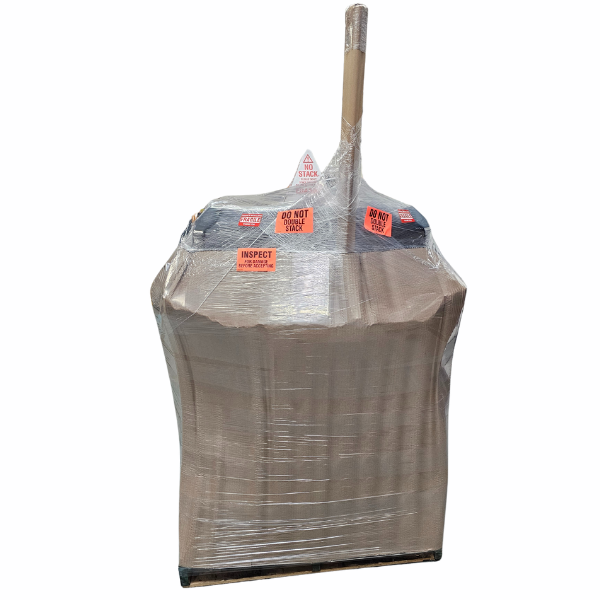
Our systems ship on pallets delivered by a freight company. If your property doesn’t have a forklift or loading dock, we can schedule a freight truck that has a liftgate to lower the system from the truck. After that, it’s your responsibility to store the pallet in a safe location indoors where it will be protected from weather or being misplaced.
Every system is different and the size of the pallet varies from project to project. Part of our quoting process is to provide an estimate for the freight delivery. We do not upcharge on shipping, so when we invoice for the system, only the exact amount is billed.
We include insurance on all freight shipments. If damage occurs during shipping, we will send replacement parts and file a claim with the freight company. Your job is to notify us immediately of the damage and send pictures of the damage so that we can make the claim.
Yes! Our systems have been designed so people can install them without special tools, extra hardware or plumbing experience. For the AquaBundance system, all of the plumbing connections are Quik-loc, Uniseal or Fernco connections that don’t require any cutting, priming or gluing. We provide highly visual assembly manuals for the frame and plumbing systems. As always, we are here to support you the entire way and will be happy to assist if you have any questions during the installation.
If your system is large enough, we are also available to travel to complete the install for you. We normally discuss installation during the preliminary quoting stage so that we can forecast installation dates and fees.
Absolutely! We have three options for system: Stock, modular, and custom. For modular and custom options, our detailed design process dives into your project goals, the intended space for the system, and budgetary considerations. Once we have all the necessary information, we will provide concept layout drawings to show you exactly how the system will fit, how much food you can expect, and most importantly, the cost. We have solutions for every space, size, goals, and budget!
Yes! We have open enrollment for on-the-farm courses for 2025. Our in person classes will be taught over two days consisting of both classroom sessions and hands on demonstrations within fully operational aquaponic greenhouses in various locations across the country. For more information about the in person courses and how to secure your spot, click here.
For life! Our courses are pre-recorded so you do not have to watch them all at once. Whether you purchase the entire course or individual modules, you have unlimited lifetime access to watch, re-watch, and learn at your own pace.
Your courses can be accessed by clicking on the My Account button in the top right corner of the website and selecting Courses from the drop down menu. Click the download link for a PDF with more detailed instructions with screenshots.
Online Course Login InstructionsYes, you will need to create an account when you purchase either an individual course or the complete farm course. If you don’t have an account already, you will need to create one during the check out process. The nice thing is that once you check out, you are automatically logged in and can view the course right away by clicking the My Account button in the top right corner of the website and selecting Courses from the dropdown menu.
Individual courses range anywhere from 90 minutes to 4 hours! You do not have to watch it all at once. When you complete individual units within a course module, your progress is updated on the course syllabus located in your account settings. You must be logged in to see your course progress.
Yes! If your system is large enough, we are able to travel to complete the install for you. We normally discuss installation during the preliminary quoting stage so that we can forecast installation dates and fees. Travel and lodging fees will apply including the day rate for labor.
If you would like us to install your system, please contact one of our sales and design team specialists. They will discuss your project and location to determine an installation plan.
This will depend on a variety of factors such as available light, nutrients, humidity, water and air temps, pH, oxygen and air flow to name a few! Each Growasis product page has production tables showing estimates of annual and weekly plants based upon the size of the system. For maximum production we recommend seeding, transplanting and harvesting on a consistent basis, The frequency of these activities will depend on the environmental factors noted above along with other potential sales, distribution and market factors.
Short Answer: Some Growasis systems require 3/4″ thick plywood and/or foam insulation panels. These items are not practical to ship.
 In the case of Growasis Elevated or Double Decker systems, you will need to pick up one or more 3/4″ x 4′ x 8′ sheets of OSB plywood for the liner support. Only use OSB plywood at the recommended thickness or greater to prevent sagging and potential breakage due to the water weight. The number of boards you need will be indicated by the dimensions you input into the design calculator on each Growasis product page.
In the case of Growasis Elevated or Double Decker systems, you will need to pick up one or more 3/4″ x 4′ x 8′ sheets of OSB plywood for the liner support. Only use OSB plywood at the recommended thickness or greater to prevent sagging and potential breakage due to the water weight. The number of boards you need will be indicated by the dimensions you input into the design calculator on each Growasis product page.
Should you require insulation panels for your trough use only 1″ x 4′ x 8′ standard foam board insulation.
Short answer: It depends on which Growasis you choose and the length of the system.
The tools you might need are (Circular Saw, Utility knife)
Our Growasis elevated and double decker systems require you to purchase 3/4″ OSB plywood paneling to support the liner and water weight. Modular systems starting at 8′ lengths and increasing by 8′ lengths (8′, 16′ 24’…) will not require any cross cuts of the plywood. However, modular raft systems starting at 12′ and increasing by 8′ lengths (12′, 20′, 28’…) will require one of the panels to be cut as a 4×4′ section. When you pickup your plywood check with your local supplier (ie Home Depot or Lowes) as they may provide free cuts on site so you don’t have to.
Our 2′ wide Growasis Elevated Raft Systems will require a 2′ wide piece of plywood. In this case a rip cut lengthwise through the plywood will be required. Again check with your local supplier. Otherwise any plywood cuts can be performed with a circular saw following the directions and equipment safety recommendations.
For Growasis Ground Level Systems we strongly recommend laying full size rigid insulation panels (1″ x 4′ x 8′) on the ground between the framing system. This will help to keep your water from losing valuable heat into the ground below. For 8′ wide troughs, the frame is designed to allow for two full size sheets to fit between each 8′ cross bar support without needing to cut the insulation panels.
You also have the option to add 1″ insulation panels into the sidewalls between the vertical support pipes. These panels can be cut to fit with a utility knife according to the directions. This must be done before installation of the liner.
Each farm utilizes a single main pump in normal operating mode running continuously. When running in decoupled mode the farm utilizes two pumps simultaneously, one for the fish system and one for the plant system. We also use Alita air pumps for the 24/7 Aeration system required to provide dissolved oxygen to the water. We offer options to heat the water using propane, natural gas or electric as well. Electric heat can be expensive and can significantly increase the energy footprint of the farm. If you need to heat the water we generally recommend one of our propane or natural gas heating units. These units can be sized appropriately for each farm based upon the total water volume and expected temperature delta.
Each farm we design is different so we provide an electrical drawing for outlet locations and an electrical schedule detailing all of the operating components, expected run times and power consumption.
That depends on the size of your Growasis Floating Plant System. When you place your order we will contact you with a freight estimate to your shipping address.
Absolutely!
We’ve made the framing system super easy to install. You can even move the frame around (before water is in) to get it positioned exactly where you want it. We have an installation video and manual to guide you through the process. All pipes are pre-cut and labeled so you know how to fit everything together. The metal fittings secure to the pipes with a simple hex key (supplied) or you can use a drill with a 5/16″ hex bit to make it go even faster. Should you be using insulation panels for the sidewalls you will need to cut those to fit between the pipes following the directions.
The Duraskrim liner installs over the framing system. Depending on the size of your trough it may be helpful to have some extra hands for the liner install so you can carefully guide and position the liner onto the frame. Once the liner is installed (following the supplied directions) you can insert the bulkhead fittings through the liner and endwall panel(s).
Depending on the size of the Growasis Plant System you purchased, you can have yours built and ready to fill with water in less than an hour. As always, we are here to help and want to make sure your installation goes smoothly. Please reach out to us if you have any questions.
There are a lot of ways to grow crops so why grow in deep water?
- Plants don’t die when the power goes out – This cannot be claimed with any vertical or NFT based growing system. In our DWC troughs, plant roots are constantly submerged in nutrient rich water staying hydrated even during an extended power loss or pump failure.
- Precise crop spacing – We use Beaver Plastics food grade lettuce rafts boards that have evenly spaced, pre cut and tapered holes for planting seedlings. For example, a 28 hole raft board will allow you to plant up to 3.5 plants per sq ft. This is important particularly for commercial growers who are producing specific quantities for market. Production and financial metrics can be easily determined. Plant spacing can be modified depending on the type of crops.
- Thermal Mass and Stability – Water is the best source of thermal mass. In other words, it retains heat extremely well compared to other materials. The large volume of water in a Growasis Floating Raft System provides greater buffering capacity and stability in water temperature, pH and other water quality parameters. A large volume of water can also help to passively heat and cool your growing environment.
- Easy Planting and Harvesting – Crops can easily be transplanted from a nursery directly into the raft boards. Harvesting can be done right on the raft boards at the trough or the raft boards can be picked up and moved to a convenient height and location for harvesting. Our Growasis elevated systems make it even easier by being conveniently positioned at waist height.
- Proven Technology and Results – Deep water culture growing has been around for decades and has been proven as an excellent growing method through extensive research and commercial applications. Our farms have used deep water growing systems for years and they have been the preferred growing method among all of our farmers producing thousands of crops every week.
There are a few other DWC systems on the market and usually they are sold as part of a complete farm package. Here are a few features of other systems to watch out for and how ours compare.
The Framing System – Other DWC troughs on the market use way too much expensive metal framing and fittings then are necessary. This increases the cost and complexity of your troughs. In addition, you have to fasten the framing system together with self tapping screws which requires an impact driver and leaves metal shards everywhere. In some DWC framing systems the sharp metal frame edges are fully exposed on the outside of the trough showing the insulation panels. This is very unsightly and you could easily cut yourself when working along side the troughs.
Growasis troughs have no sharp edges, no cutting or drilling and no visible insulation boards.
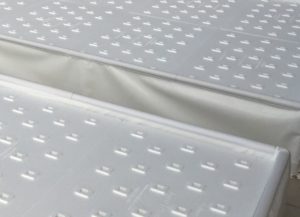
Growasis Floating Plant System
Raft Boards
Other DWC systems on the market require you to purchase your own insulation panels to be used as floating plant rafts. There are so many things wrong with this it’s hard to know where to start. Here’s a quick bullet list of issues.
- Manufacturers of insulation panels (like Dow) have publicly discouraged the use of insulation boards for plant or food production yet suppliers continue to promote their use.
- Pink or blue insulation boards are not ideal as they do not reflect the light back to the plants as the white boards do. There are suppliers who even recommend painting the insulation boards so they can be white. This practice is a waste of time and now you have latex paint peeling off your boards and getting into your food production system. Not good…
- When using insulation boards you have to not only cut all the boards but then you have to drill potentially thousands of little holes which creates a huge mess and is extremely labor intensive! This is arguably one of the worst things we’ve ever had to do in our early years in aquaponics. Why drill holes in insulation boards when there is an affordable food grade and pre-drilled solution already out there?
EPDM pond liner
Some suppliers also use heavy duty 45mm black EPDM pond liner for their troughs. This type of liner is extremely heavy and difficult to work with compared to the light weight 20mm structurally reinforced DuraSkrim liner. EPDM is great for lining ponds because it stretches and forms well to uneven surfaces but that feature as actually a drawback in DWC applications. Duraskrim liner is also white which is a good thing because it allows you to easily see your airstones and any accumulation of detritus in your troughs. EPDM is also a petroleum based product which is not recommended in food production applications.
Only virgin resins are used in the production of the DuraSkrim. All resins used in the food contact layer are FDA 21 CFR 177.1520 (c) 3.2 compliant. “Dura-skrim has been approved as a material in organic farming.”
Jeff Evard
Certification Manager
Ecocert ICO LLC
First of all we appreciate everyone, including our competitors, who is working to advance better ways of growing food and promoting aquaponics. We don’t disparage others in the industry and we encourage people to take as many classes and workshops as they can from reputable aquaponic companies.
However, we do advise people to do their research and make sure they are working with companies and consultants who have a proven and experienced track record. There are many important aspects of designing an ecologically balanced system to ensure consistent and successful long term operations. Companies should have a minimum of five years of experience operating farms as a business along with designing, building and supporting systems. Make sure they can demonstrate the successful completion of projects and provide customer references.
Make sure the company has the capability to manufacture and deliver a fully functioning system with all of the parts and equipment you need to build and operate the farm.
Our Flourish Farm systems are sold turnkey so everything you need for a fully functioning system is included except the fish and plant seeds. There are a few items such as foam insulation board or plywood for elevated DWC troughs that cannot be shipped and have to be picked up locally. Your final quote will indicate whether those items are included in your quote or need to be purchased by you.
Here’s a comprehensive list of everything included with our Flourish Farm Systems
- Fish Tanks (with optional window kits)
- AST Polygeyser Filtration System
- Growasis Modular Raft System(s) – Ground level, Elevated or Double Decker – All Growasis systems come with our easy to assemble metal framing system, insulation panels for underlayment and sidewalls, Duraskrim 20mm liner, aeration system and Food Grade Beaver Rafts Boards
- Low noise linear air pumps, air diffusers and air distribution tubing for fish and plant systems
- Submersible or External pumps for the main fish and plant system
- Growasis Vertical Nursery and Microgreen System with shelving rack, LED lights, flood tables, nutrient reservoir, pump, aerator, timer and all plumbing components
- Aerobic Mineralization Tank
- Active carbon filter system with automatic water top off
- Optional Autopots or AquaBundance Modular Media Bed system – Includes powder coated metal framing, grow beds, growing media, all plumbing components (light rack optional)
- Optional Artificial Lighting Systems
- Optional Monitoring and Alerting System
- Clean-out valves with a hose hookup should you need to purge a major plumbing line
- Industrial pipe covering ramp for plumbing that crosses the walkway or trench covers for below ground pipe trenches
- All PVC pipe, fittings and valves
- Farm cycling, pest management, water test kits and nutrient adjustment solutions.
- Plug trays for seedlings
- Fish net, fish feed
It Depends… (You probably saw that one coming). There’s a lot to be said on this topic but here is one way of addressing the “it depends” answer. The following tables present a range of hypothetical production numbers, price points and the resulting potential gross revenue. The second table lists several of the many factors that will influence those numbers. In order to achieve profitability in your farm you will have to manage these factors (and others) to ensure the best production and financial performance for your farm. In our Flourish Farm Business Course we spend a lot of time focusing and training farmers on how to manage these factors.
Cells in dark green illustrate the wide range of potential revenues a farm can theoretically have based upon price vs. annual harvests. Average Culture Time represents the time from which the seedling was transplanted into the main DWC troughs to when it was harvested. One farm may be turning their product at a much faster rate than another farm and selling at a much higher price point. In other words, two identical farms can perform much differently depending on the variety of factors listed below. In general, your farm will likely perform somewhere in the middle of the range represented by the green cells.
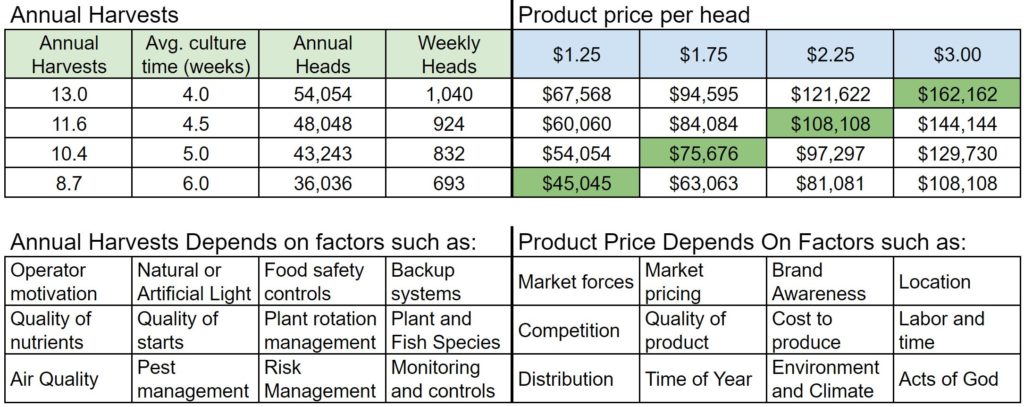
Water from the fish tanks feeds by gravity through the filtration system. Fish solid waste is captured in the filter and bacteria on the surface of the biofilter media convert toxic ammonia to nitrates. An aerobic digester tank allows solids that are removed from the filter to be further “mineralized” to maximize nutrient availability. These additional nutrients can be reintroduced to the system or used for other crops. Following the filter water flows into the dual sump system. The dual sumps can be connected or disconnected (discussed further in decoupling). Water is pumped back to the fish tank and also simultaneously to the plant systems. Water pumped to the plant systems returns back to the sumps. Low noise linear air pumps provide aeration to the fish and plant systems.
The recirculating nature of the farm allows for reuse of water and absorption of nutrients which are continuously being produced by the fish. No water needs to be discharged from the farm. Water will need to be topped off periodically due to natural losses from evapotranspiration which are detailed in the energy and water section of this document.
Being in Colorado, we often think of passive solar greenhouses as great structures for growing in high altitude cold seasonal climate environments. After all, a good passive solar greenhouse, like the ones designed by our partners at Ceres Greenhouse Solutions in Boulder, is an excellent way to grow year round with fewer energy resources than the typical inefficiencies of common greenhouse structures. However, when it comes to growing in Florida, or other traditionally hot and humid climates, the question of whether or not a highly insulated “cold climate” structure is necessary is certainly worth exploring. For a deeper understanding of actual energy utilization please visit the Ceres website to learn more about their greenhouses and energy calculations.
A properly designed and maintained aquaponic system should not produce any foul smells. When growing fish, you can expect a slight odor, but it should not be offensive. If you have an effective fish waste solids management system (meaning an adequate bacteria population and/or mechanical solids filtration) you should not expect your system to be very smelly. A healthy, aerobic (oxygenated) aquaponic system is what we strive for, and will not smell any more than the smell of a healthy soil garden. Anaerobic zones (oxygen-lacking) within the growbeds, pipes, or other areas of your aquaponic system will cause a foul, sulfur smell. It will be necessary to unclog any anaerobic zones and possibly add air stones to the area to keep the system healthy and odor-“less”.
Often a dead fish in your tank may be the culprit of a foul smell, so be sure to check in on your fish frequently and ensure that you have easy access to the fish tank.
There are fish species that can tolerate low temperatures, Koi can manage to overwinter in below freezing temperatures outside. Trout and salmon are other species that prefer colder temperatures. Most other fish species will not survive outside through a freeze, so be sure to check the temperature range of the fish you intend to grow.
Both plants and bacteria cannot survive temperatures around or below freezing (0°C – 32°F), so growing outdoors through the winter isn’t feasible without a greenhouse to keep extreme temperatures regulated. Without bacteria, you can expect ammonia levels to build up in your tanks, eventually killing your fish.
Yes! Because fish are cold blooded animals their waste does not, and cannot, contain either of these pathogens. In fact, there was a recent study done by the College of Tropical Agriculture in Hawaii titled “A Preliminary Study of Microbial Water Quality Related to Food Safety in Recirculating Aquaponic Fish and Vegetable Production Systems” that explored this very question and concluded that in general aquaponically grown food is even safer than soil grown food! Click the link above to read the report of the study findings.
While they are both soilless growing techniques, aquaponics differs from hydroponics in many significant ways. The biggest difference; in aquaponics, the fish provide the nutrients for the plants, where in hydroponics, the plants grow from synthetic nutrients added to the water. For more information, visit our What Is Aquaponics? page.

Absolutely.
In fact, it doesn’t work unless it is organic. The entire system is connected, so trying to fix an issue for one part of your aquaponics system will affect the whole thing. Adding chemicals, antibiotics, or other artificial additives to your aquaponic fish tank would eventually end up harming your plants. If you use pesticides or growth stimulants to aid your plants, it will harm your sensitive fish. Every element that you add to your system must be plant-safe, fish-safe, and definitely nothing that’s anti-bacterial!
In terms of official USDA Organic Certification, commercial aquaponic farms are eligible to be certified. There are strict standards that farm managers must follow, which regulate nutrient additions, pesticide use, food safety, and other aspects of farm operations. For more information, reach out to your local organic inspector.
There are many benefits to growing your food with aquaponics. Remember that aqua stands for aquaculture – raising fish. Ponics – in Latin means to work. Hence, you are putting your fish to work, growing plants! Here are some of the benefits of growing with aquaponics.
- Aquaponics is Sustainable – From efficiently using precious water resources, to producing no waste, aquaponics is sustainable in so many ways. Check out our blog, “7 Ways Aquaponics is Sustainable” for the full run down.
- Aquaponics can be used anywhere – While soil is immensely valuable in growing gardens, there are places which have very poor soil or no soil at all. Sand, heavy clay, asphalt or concrete, soil contaminants or rocky terrain make it difficult if not impossible to grow. Aquaponics, however, allows growing in a wide variety of places. It can be built on parking lots, rooftops, backyards and basements. It allows for growing indoors or outdoors. In addition, Aquaponics can grow year-round where ever you can control the temperatures. Here are some of the benefits of growing with aquaponics.
- Aquaponic is local – It doesn’t get any more local than growing food in your home, school, or small community farm. Most food travels thousands of miles to get to our plates and by the time it arrives it has lost much of its nutritional value. Why not grow more of our produce and protein locally to help the environment.
- Aquaponics is Organic – Growing your own vegetables, fruits and herbs will provide you the most nutrient dense food possible. Aquaponics is a natural ecosystem without any harmful chemical fertilizers and pesticides used in commercial agriculture. Feel confident that you know exactly what’s in the food you’re eating because you grew it yourself!
- Food Security – Food independence and security is increasingly important in these changing times. Aquaponics is one way of living a more self-reliant lifestyle. By adding in solar powered systems and energy-conserving building practices, we can start to see the possibility for everyone to grow their own food.
Pet and Aquarium Stores: Just about any fresh water aquarium fish from a pet store works well as an aquaponics fish. Pay special attention to the temperature range that the fish thrives in, and whether they would be compatible with the other fish in your tank (i.e. not eat them). If your system is very small you might be able to stock your tank simply by visiting your local pet store. Pet store fish we have grown with success in aquaponics so far are goldfish (avoid feeder goldfish, they are prone to disease), koi, oscars, pacu, and guppies.
Hatcheries: More and more fish hatcheries are willing to sell small batches of fish to local aquaponic growers. If you have a hatchery nearby that is willing to sell to you this is a great option if you plan to grow fish to eat.
Online: You can look for local or national fisheries online and order many species through the web to arrive via mail. Please note that live fish are shipped with a limited oxygen supply, so make sure to receive them as soon as they arrive to ensure they don’t stress in extreme oxygen or temperature situations. Specific species may be prohibited in your area, so please be sure to check with your local regulations before ordering.
Yes! And we are proud to be the first company in the country to offer an Organic Aquaponic Fish Feed! Our AquaOrganic feed is free of fish meal, GMO’s and soy. It is the only fish food available that is USDA Certified Organic.
Learn more about the organic nature of aquaponics in our blog post Is Aquaponics Organic?

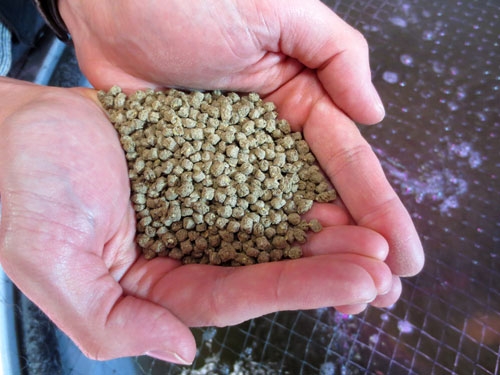 So, what do you feed aquaponic fish? Depends on what type they are. Carnivorous (examples – trout, perch, and bass) require a feed that has high levels of protein (45 – 50%). Omnivorous fish (examples – tilapia, bluegill, koi, and catfish) require a lower protein feed (typically 32% protein). Younger fish require more protein than mature fish.
So, what do you feed aquaponic fish? Depends on what type they are. Carnivorous (examples – trout, perch, and bass) require a feed that has high levels of protein (45 – 50%). Omnivorous fish (examples – tilapia, bluegill, koi, and catfish) require a lower protein feed (typically 32% protein). Younger fish require more protein than mature fish.
While we applaud the efforts of those who try to further feed aquaponic fish by producing their own feed (such as cultivating their own Black Soldier Fly larvae, red worms, and duckweed) we still strongly recommend that you feed your fish a professionally formulated feed. This will ensure that not only do these fish that are in your care receive an optimal diet for their health but that your plants also get a balanced diet through their waste.
In an aquaponic system, the fish feed is one of the most important inputs. There is a direct relationship between the feed going into the system and the growth of your plants. Think about it: You add feed into the system, the fish eat the feed and produce ammonia, bacteria convert ammonia into nitrates, the plants consume the nitrates and grow. Because of this relationship, balancing the proper amount of feed entering the system is essential to the overall success of the system. When sizing an aquaponic system, you can use the formula, 20 g of feed per square meter of Deep Water Culture growing area. Using this formula, you can calculate the amount of feed needed in your system.
Only feed the fish what they will consume in 5 minutes – scoop out any uneaten fish food to avoid unwanted water quality issues. If your aquaponic fish don’t seem to be hungry don’t feed them. Fish can survive for weeks without feeding.
If you are cycling your system with fish, feeding should be kept to a minimum during the first 1-2 months. Once your nitrifying bacteria levels can quickly digest ammonia and nitrites in your system, increase feeding levels, again paying attention to how much the fish consume in 5 minutes. We prefer to feed our fish 2-3 times per day, to encourage a steady metabolic digestion rate and maintain a steady amount of solids. As a guideline, the chart below can be used to determine what percent of their body weight your fish should eat based on their size.

Looking for fish feed? We have you covered with our AquaNourish and AquaOrganic (certified by the USDA) lines of nutritious fish feed.
Yes, we like to refer to this as “Fish Cycling,” meaning you will be monitoring the health of your fish population while simultaneously growing the nitrifying bacteria population. Adding the fish before the bacteria does come with some additional challenges, so see our post on Cycling With Fish for special considerations when doing this.
In a smaller sized tank, <50 gallons of water, we recommend stocking the tank with 1″ of fish for every 1 gallon of water. For example, a 10-gallon tank could hold 10x 1″ fish or 5x 2″ fish.
For larger fish in tanks over 50 gallons, we recommend a stocking density of 1 lb of fish per 5 -10 gallons of water, or 1-2 fish per 10 gallons of water. Do not stock more than 1 pound of fish for every three gallons of water, this will greatly increase the potential for fish stress, fish diseases, and an overall imbalance of your aquaponic system.
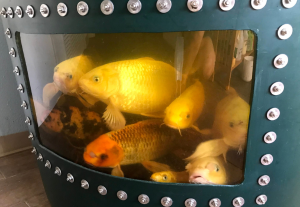 The Best Fish for Aquaponics
The Best Fish for Aquaponics
The first decision to make when selecting fish is if you plan to grow edible fish for harvest or ornamental fish for enjoyment. You can have both types living together in one tank. Other factors are growth rate to harvest, water temperature, tank size, etc.
Aquarium (ornamental) fish should be stocked at roughly 1″ per 1 gallon of water. That could be many smaller fish like guppies or dannos. It could also mean a few larger koi, pacu, or oscars.
Edible fish need at least 50 gallons of water to grow to a reasonable size. Less than this means ornamental, pond or aquarium fish are a good option.
By far, the most popular fish in aquaponics if tilapia. They have rapid growth rates, can handle a wide range of temperatures, and hardy, and are harvestable.

You’ll want to consider the natural environment that the fish species comes from to ensure that your aquaponic system can provide a similar environment. Trout, for example, like water temperatures below 65 degrees. Can your environment consistently provide this? If you are mixing fish species together in the same tank, be sure that they have similar living requirements (koi, tilapia, catfish). Do they all prefer the same water temperature, eat the same food, and have the same oxygen requirements?

- Tilapia and catfish can grow in warmer water, but warmer than 75°F is not ideal for most plants, and can be a breeding ground for undesirable pests and diseases.
- Water temperatures below 68°F are possible with various cool-water fish species, but nitrification and plant growth will slow substantially.
Because of the varying preferences of water temperatures, staying between 70-72° is a happy compromise that keeps bacteria, fish, and plants in a comfortable range. Trying to grow fish or plants outside the optimal range usually results in stress.
Don’t mix carnivorous fish (walleye) with herbivores, or you will find that you are just providing an expensive meal for your carnivores! We have found that tilapia, other cichlids such as oscars, pacu, goldfish, and koi all co-exist well together in an aquaponics system.
For more information on fish health, selection, and management, check out our Fish Health and Management Course.
Testimonials
What our Customers are Saying
“I want to say thanks to you, JD, and Tawnya for all the help along the way.I wouldn’t be anywhere close to where I am without the discussions, class training at your facility and aquaponic tours. It is much appreciated and worth the investment in time. “
“You guys have thought of everything … I don’t want to have to figure all this stuff out. I just want it to work”
“What an exceptional class full of wonderful real knowledge and detailed information from A to Z in Aquaponics put together and presented by two people that are genuinely passionate and caring! Thank you Tawnya and JD for the wonderful experience!”
“Most thankful for the class for the transparency, not just for the success, but also for their failures. I believe that their transparency on their failures will help me to reach a state of production sooner. I believe that the realistic backing for the data and the numbers has been crucial for me to finish my business plan with realistic expectations. I cannot imagine attending a more valuable course than this one.”
“This course is very rich in information for fish, plants, and how to start your farm. I think I can avoid many stupid errors or mistakes so these three days have been very nice. I definitely recommend this class because it teaches the business approach to Aquaponics.”
“Thank you JD & Tawnya for a great week long aquaponics course! You guys both did a great job presenting solid helpful information and kept the class motivating and interesting. Looking forward to getting our first farm up and running after your in depth – detailed course curriculum.”

